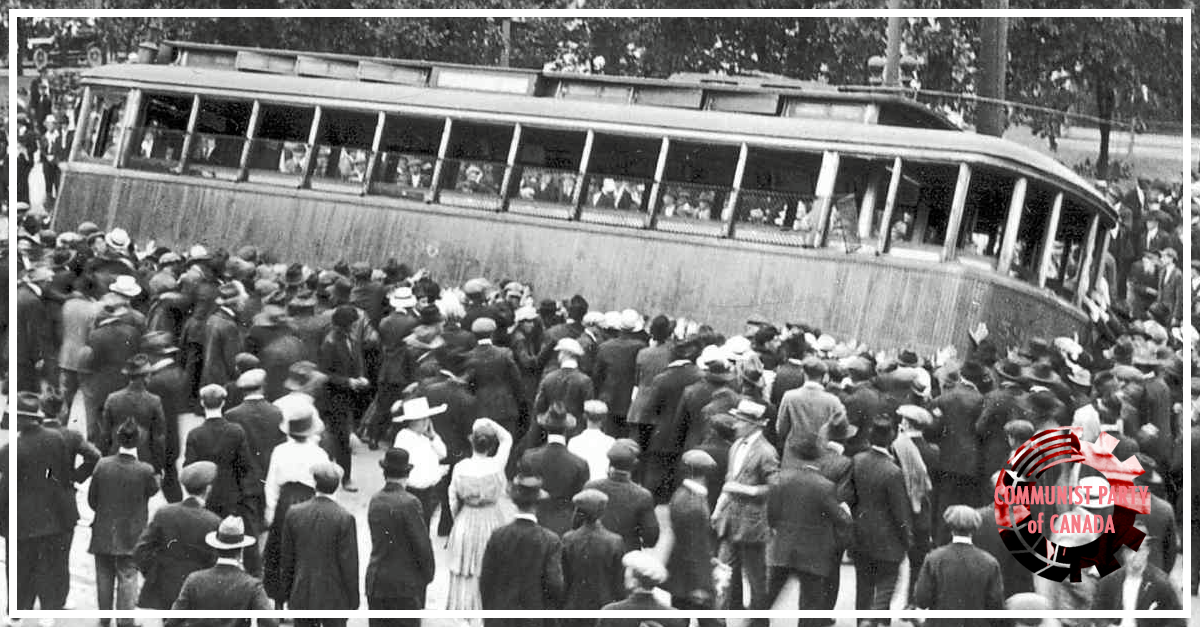97th anniversary of the Winnipeg General Strike
The labour movement across Canada, and especially in Winnipeg, will mark the anniversary of the Winnipeg General Strike this year. The Communist Party of Canada welcomes these celebrations and will work for the success of these important tributes.
The 1919 Winnipeg General Strike is one of the greatest working class struggles in Canadian history, a strike that combined the militancy, enthusiasm and solidarity of the overwhelming majority of Winnipeg’s workers against the capitalist big shots who still trample on the rights and lives of workers.
Years of hunger and misery brought about by a war‑time government wage freeze and the crushing lack of rights had already created enormous grievances and rising militancy in Winnipeg’s rapidly growing working class.
Socialist and working class activists from many lands had already organized for decades throughout the burgeoning cities of Western Canada, among which Winnipeg was the largest.
Adding to the spirit of resistance was a long list of recent struggles by the Métis people, farmers, trade unions, women and others against encroachments by the Eastern industrial magnates who were behind the colonization and exploitation of Western Canada.
After witnessing the shattering bestiality of imperialism’s First World War (1914‑1918), the majority of trade union activists in Western Canada embraced the 1917 socialist revolution in Russia as a giant beacon for humanity and international solidarity.
In the months leading up to the strike, large trade union conferences in Western Canada resounded with demands for the industrial form of union organization and for a six‑hour working day to reduce the devastating effects of unemployment at the end of the War. Delegates advocated a general strike to back up their demands.
They overwhelmingly passed resolutions of solidarity with the Soviet government, demanding the return of Canadian soldiers sent to Russia to crush the revolution, and for working class power in Canada.
Not even the brutal suppression of socialist and working class political organizations by the Borden government’s War Measures Act in 1918 could stop the impending explosion.
The strike began with the refusal by employers to recognize the Metal Trades Council and enter negotiations for a collective agreement. The metal workers struck on May 1. Other unions voted to strike in solidarity and on May 15, 35,000 workers began a general strike which lasted until June 26. The first out were 500 women telephone operators who left work at 7:00 a.m.
Women, immigrants and other highly exploited workers were solidly behind the strike. Nearly half of all strikers were not members of unions. Veterans returned from the War actively supported the strike. The strike’s broad support created fear and anger in the hearts of the bosses who used reactionary terror, arrests and the Mounted Police to crush the strike.
On “Bloody Saturday”, June 21, mounted police attacked a rally, murdering two workers and wounding 40 others. The government sent machine gun‑equipped army patrols onto the streets. Soon after the shooting, the strike committee ordered workers to return to work.
The full weight of the capitalist state was used to crush the strike, but the metal workers won a collective agreement. The Strike was the high point of a sharp and temporary Canada‑wide surge in organizing workers and efforts to achieve legislated union rights.
At least 34 smaller sympathetic general strikes took place in cities and towns across Canada during the Winnipeg General Strike, mainly in the Western provinces but also in Toronto and Amherst, Nova Scotia. An upsurge of all kinds of strikes took place in every province and Quebec.
The Winnipeg General Strike had a positive influence on the labour movement for many years. Not only did it shape the key demands of the labour movement, it educated workers about the true nature of the capitalist state.
It took until the 1930s for the first sustained advances in organizing workers into industrial unions and until after the Second World War to achieve similar advances in legislated collective bargaining rights across Canada, rights which are under threat from right wing governments in Canada today.
Some of the demands of the labour movement in Western Canada leading up to strike, such as for a six hour work day and working class power, have yet to be realized.
The Winnipeg General Strike must be counted among the many important global working class actions sparked by the crisis at the end of the War and inspired by the tremendous example of the Russian revolution.
The explosion of international working class militancy was of decisive importance for the survival of the Soviet revolution; objectively, it worked to support the popular demand “Hands off Russia!” Many of the strikers recognized that their sisters and brothers in Russia were fighting a common enemy, the capitalists of Russia, who no longer had power, and the capitalists of Canada.
But it was the immediate aim of the General Strike to alleviate the intolerable conditions for workers in Winnipeg that the made the strike such a powerful blow against Canada’s wealthy elite.
The strike galvanized revolutionary workers to overcome arrests, deportations and illegality to form the Communist Party of Canada in 1921, an achievement that is still vital for the many international and national challenges that confront the working class today.
Resolution adopted by the Central Committee, Communist Party of Canada, January 31‑February 1, 2009

